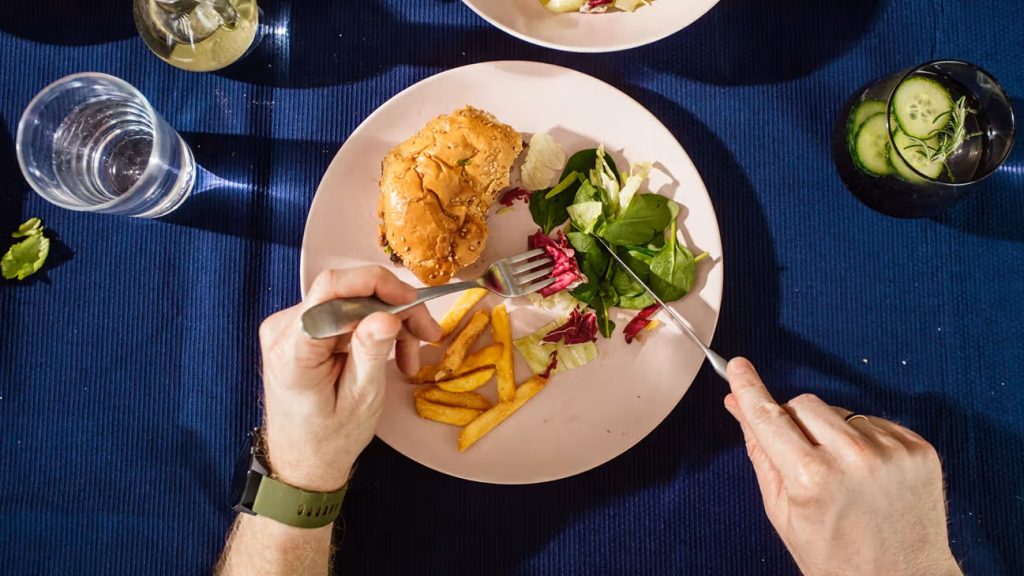You finish an entire bag of chips while scrolling through your phone and suddenly wonder, “Did I even taste those?” Or maybe you wolf down lunch at your desk between emails, barely registering what you’re eating. Sound familiar? You’re not alone. Most of us have developed a complicated, often unconscious relationship with food that leaves us feeling disconnected from our bodies and frustrated with our eating habits.
The constant cycle of restriction and overindulgence, eating when stressed, or mindlessly consuming food while distracted has become the norm rather than the exception. But what if there was a way to break free from this pattern and develop a peaceful, intuitive relationship with food that actually supports your wellbeing?
Enter mindful eating – a practice that’s less about what you eat and more about how you eat. It’s not another diet or set of food rules, but rather a fundamental shift in how you approach meals and snacks that can transform not just your relationship with food, but your overall quality of life.
What Mindful Eating Really Means
Mindful eating isn’t about eating slowly just for the sake of it or following rigid rules about when and what to consume. At its core, it’s about bringing conscious awareness to the entire eating experience. This means paying attention to your body’s hunger and fullness cues, noticing the flavors, textures, and aromas of your food, and being present with the act of nourishing yourself.
Unlike traditional dieting approaches that focus on external rules and restrictions, mindful eating encourages you to tune into your body’s internal wisdom. Your body is incredibly intelligent – it knows when it needs fuel, what nutrients it’s craving, and when it’s had enough. The problem is that years of dieting, stress eating, and external food messaging have made it difficult to hear these natural signals.
Conscious eating habits develop when you start treating meals as opportunities for self-care rather than inconvenient necessities or sources of guilt. It’s about creating space in your day to actually experience your food rather than rushing through meals or eating on autopilot.
Breaking Free from Autopilot Eating
Most of us eat in a state of partial consciousness at best. We’re checking emails during breakfast, scrolling social media during lunch, or watching TV during dinner. This constant multitasking while eating disconnects us from our body’s signals and prevents us from actually enjoying our food.
Autopilot eating often leads to that uncomfortable feeling of eating too much without really tasting anything, or finishing a meal and still feeling unsatisfied despite being physically full. When your attention is divided, your brain doesn’t register the eating experience fully, which can leave you feeling like you haven’t really eaten at all.
The first step toward mindful eating is simply recognizing when you’re eating unconsciously. Start noticing when you reach for food out of boredom, stress, or habit rather than genuine hunger. There’s no judgment here – just awareness. Once you begin to recognize these patterns, you can start making different choices.

Tuning Into Your Body’s Wisdom
Your body has been giving you signals about hunger and fullness your entire life, but diet culture and busy lifestyles have taught many of us to ignore or override these cues. Rediscovering this internal guidance system is one of the most powerful aspects of developing conscious eating habits.
True hunger typically develops gradually and is accompanied by physical sensations like a gentle rumbling in your stomach, decreased energy, or difficulty concentrating. It’s different from emotional hunger, which tends to come on suddenly and is often accompanied by cravings for specific comfort foods.
Fullness, on the other hand, is a spectrum rather than an on-off switch. Learning to recognize the subtle differences between satisfied, comfortably full, and uncomfortably stuffed takes practice. Most people are either eating while distracted or eating so quickly that they miss the gentle signals their body sends about satisfaction.
The key is to start checking in with yourself before, during, and after eating. Ask yourself: “How hungry am I right now?” or “How does my body feel?” These simple questions can help you reconnect with your body’s natural rhythms.
Creating Mindful Eating Experiences
Transforming your relationship with food doesn’t require overhauling your entire life or eating every meal in perfect silence. Small, consistent changes in how you approach eating can create significant shifts over time.
Setting the Stage: Before you eat, take a moment to create an environment that supports mindfulness. This might mean sitting down at a table instead of eating standing up, putting away your phone, or taking three deep breaths to center yourself. Even these small rituals signal to your brain that eating is worthy of your full attention.
Engaging Your Senses: When you first look at your food, notice its colors, shapes, and presentation. As you take your first bite, pay attention to the temperature, texture, and initial flavors. Chew slowly enough to actually taste your food rather than just swallowing it down. This isn’t about eating at a snail’s pace, but rather about being present with the sensory experience of eating.
The Mid-Meal Check-In: Halfway through your meal, pause and assess how you’re feeling. Are you still hungry? How does the food taste? Are you enjoying it? This simple pause can prevent overeating and help you stay connected to your body’s signals throughout the meal.
Handling Emotional Eating with Compassion
One of the biggest challenges people face when developing mindful eating practices is dealing with emotional eating. Using food for comfort, stress relief, or entertainment is incredibly common and completely human. The goal isn’t to never eat emotionally again, but rather to approach these moments with awareness and self-compassion.
When you notice yourself reaching for food when you’re not physically hungry, pause and ask yourself what you’re really needing in that moment. Are you tired and need rest? Stressed and need a break? Lonely and need connection? Sometimes food is the most available comfort, and that’s okay. But often, addressing the underlying need directly can be more satisfying than eating.
If you do choose to eat for emotional reasons, do so mindfully. Sit down, put the food on a plate, and pay attention to the experience. This prevents the shame spiral that often comes with mindless emotional eating and helps you learn from the experience rather than judging yourself for it.
The Power of Slowing Down
In our fast-paced world, slowing down during meals can feel counterproductive or even anxiety-provoking at first. However, eating more slowly has profound benefits that extend far beyond just tasting your food better.
When you eat quickly, your brain doesn’t have time to register fullness signals, which typically take about 20 minutes to reach your consciousness. This delay means you might eat well past the point of satisfaction before realizing you’re full. Slowing down allows you to catch these signals and stop eating when your body has had enough.
Slower eating also improves digestion. When you’re rushing through meals, your body is often in a stress state that inhibits proper digestion. Taking time to chew thoroughly and eat calmly activates your parasympathetic nervous system, which optimizes digestion and nutrient absorption.
You don’t need to time your meals or count chews. Simply putting your fork down between bites, taking a breath, or having a conversation during meals can naturally slow your pace and make eating more enjoyable.
Building Consistent Conscious Eating Habits
Like any new skill, developing mindful eating practices takes time and patience. The goal isn’t perfection, but rather progress toward a more conscious relationship with food. Start small and build gradually rather than trying to transform every meal overnight.
The One-Bite Rule: Begin by eating just the first bite of each meal mindfully. Pay full attention to that single bite – its flavor, texture, and how it makes you feel. This simple practice can anchor you in the present moment and set the tone for the rest of your meal.
Technology Boundaries: Consider creating phone-free zones during meals, even if it’s just for 10 minutes. This might feel challenging at first, especially if you’re used to multitasking while eating, but it’s one of the most effective ways to reconnect with your food and your body.
Regular Check-Ins: Throughout the day, pause and ask yourself about your hunger and energy levels. This isn’t about restricting food or following rigid eating schedules, but rather about staying connected to your body’s needs and rhythms.

Overcoming Common Obstacles
Developing mindful eating practices isn’t always smooth sailing. Life gets busy, old habits are strong, and sometimes you’ll find yourself back in autopilot mode. This is completely normal and part of the process.
Time Constraints: If you’re genuinely pressed for time, focus on quality over quantity. Even two minutes of mindful eating is better than none. You can eat quickly when necessary while still bringing some awareness to the experience.
Social Situations: Eating mindfully doesn’t mean you can’t enjoy meals with others or go out to restaurants. In social settings, focus on the aspects of mindful eating that feel natural – maybe it’s savoring a few bites more fully or checking in with your hunger before ordering.
Perfectionism: The biggest obstacle to developing sustainable mindful eating habits is the belief that you need to do it perfectly. Some meals will be mindful, others won’t, and that’s perfectly fine. Progress, not perfection, is the goal.
The Ripple Effects of Mindful Eating
When you begin eating more consciously, the benefits extend far beyond your relationship with food. Many people find that mindful eating helps them become more present in other areas of their lives. The practice of paying attention, checking in with yourself, and responding to your body’s needs naturally carries over into other situations.
You might notice that you’re better at recognizing when you need rest, more aware of your stress levels, or more tuned into what activities and relationships truly nourish you. Mindful eating is really about developing a deeper relationship with yourself and learning to trust your inner wisdom.
The practice also tends to reduce the mental energy spent thinking about food, dieting, and body image concerns. When you trust your body to guide your eating, you’re free to focus your mental resources on things that matter more to you than what you had for lunch.
Starting Your Mindful Eating Journey
The beauty of mindful eating is that you can start right now, with your very next meal or snack. You don’t need special equipment, meal plans, or extensive preparation. All you need is a willingness to pay attention and treat yourself with kindness as you learn.
Remember, this isn’t about eating perfectly or never enjoying indulgent foods again. It’s about developing a peaceful, trusting relationship with food and your body that supports your overall wellbeing. Some days you’ll eat mindfully, others you won’t, and both are part of being human.
The goal is progress, not perfection. Each moment of awareness, each time you check in with your hunger, each meal where you taste your food – these all add up to create lasting change in how you relate to eating and nourishing yourself.
Your relationship with food has been developing for your entire life. Be patient with yourself as you work to make it healthier and more conscious. The investment in learning to eat mindfully pays dividends not just in how you feel about food, but in how you feel about yourself and your ability to take care of your needs.
